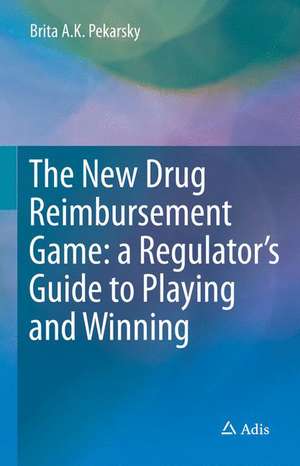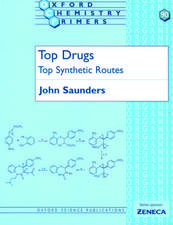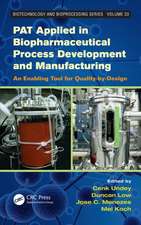The New Drug Reimbursement Game: A Regulator’s Guide to Playing and Winning
Autor Brita A.K. Pekarskyen Limba Engleză Hardback – 26 oct 2014
Price effectiveness analysis (PEA), is introduced. PEA informs the question of how the innovative surplus from the new drug should be allocated between the manufacturer and the consumer so as to optimise society’s welfare. The method allows the decisions by the regulator and the firm to be analysed jointly by specifying the firm’s production and revenue functions in terms of the clinical innovation of a new drug; the incremental effect used in the summary metric of cost effectiveness analysis. An economic value of innovation that takes into account opportunity cost under conditions of economic efficiency in the health system is proposed: the health shadow price.
The limitations of the non-strategic methods that currently inform the highly contested new drug subsidy game are presented and the relative strengths of PEA are demonstrated. Health technology assessment quantifies both the clinical innovation of a new drug and its financial impact on the health system. Cost effectiveness analysis tests the relationship between the incremental cost and incremental effect of a new drug for target patients, at a given price. PEA tests the relationship between the price of a new drug and the health of the whole population, now and into the future. It achieves this by taking into account current inefficiency in both resource allocation and the displacement process, and the relationship between price and future innovation.
| Toate formatele și edițiile | Preț | Express |
|---|---|---|
| Paperback (1) | 367.07 lei 6-8 săpt. | |
| Springer International Publishing – 22 aug 2016 | 367.07 lei 6-8 săpt. | |
| Hardback (1) | 372.03 lei 6-8 săpt. | |
| Springer International Publishing – 26 oct 2014 | 372.03 lei 6-8 săpt. |
Preț: 372.03 lei
Preț vechi: 391.61 lei
-5% Nou
Puncte Express: 558
Preț estimativ în valută:
71.20€ • 77.31$ • 59.80£
71.20€ • 77.31$ • 59.80£
Carte tipărită la comandă
Livrare economică 23 aprilie-07 mai
Preluare comenzi: 021 569.72.76
Specificații
ISBN-13: 9783319089027
ISBN-10: 3319089021
Pagini: 248
Ilustrații: XVI, 248 p. 9 illus.
Dimensiuni: 155 x 235 x 19 mm
Greutate: 0.5 kg
Ediția:2015
Editura: Springer International Publishing
Colecția Adis
Locul publicării:Cham, Switzerland
ISBN-10: 3319089021
Pagini: 248
Ilustrații: XVI, 248 p. 9 illus.
Dimensiuni: 155 x 235 x 19 mm
Greutate: 0.5 kg
Ediția:2015
Editura: Springer International Publishing
Colecția Adis
Locul publicării:Cham, Switzerland
Public țintă
Professional/practitionerCuprins
Introduction.- Reframing the political economy of new drugs.- The social rate of return on investment in pharmaceutical R&D.- The value of innovation.- The shadow price.- The health shadow price.- The health shadow price and the economic context.- The `pharmaceutical R&D financing' game.- The `pharmacotherapy needs a premium' game.- Conclusion.
Recenzii
“I like this book … and would recommend it to anyonewho wishes to understand the negotiations between health-care payers andbiopharmaceutical companies. … Pekarsky provides useful overviews of the manyacademic fields that contribute to debates on the appropriate price to pay fornew drugs … .” (Christopher J. McCabe, Applied Health Economics and HealthPolicy, October, 2015)
Notă biografică
Brita Pekarsky is a Senior Research Fellow at the School of Population Health, University of South Australia. Dr Pekarsky’s research is in the areas of pharmacoeconomics, pharmaceutical regulation and Aboriginal health care financing. She received her PhD from the University of Adelaide, jointly in Economics and Population Health. Dr Pekarsky is on the Editorial Board for Applied Health Economics and Health Policy. She was a member of the Economic Subcommittee of the Australian Pharmaceutical Benefits Advisory Committee from 1997 to 2013.
Textul de pe ultima copertă
This comprehensive text presents a rigorous framework from within which regulators can respond strategically to the claim by the pharmaceutical industry that lower drug prices today lead to a loss for the population’s future health due to less innovation. It starts with a critical review of the empirical evidence of the return to consumers on their ongoing investment into high drug prices in order to increase future innovation. The implicit, critical and unrealistic assumption inherent in these studies is identified, namely that the health budget can be expanded to purchase drugs at higher prices without an opportunity cost, for example, the foregone benefits of alternative investments in health care infrastructure.
Price effectiveness analysis (PEA), is introduced. PEA informs the question of how the innovative surplus from the new drug should be allocated between the manufacturer and the consumer so as to optimise society’s welfare. The method allows the decisions by the regulator and the firm to be analysed jointly by specifying the firm’s production and revenue functions in terms of the clinical innovation of a new drug; the incremental effect used in the summary metric of cost effectiveness analysis. An economic value of innovation that takes into account opportunity cost under conditions of economic efficiency in the health system is proposed: the health shadow price.
The limitations of the non-strategic methods that currently inform the highly contested new drug subsidy game are presented and the relative strengths of PEA are demonstrated. Health technology assessment quantifies both the clinical innovation of a new drug and its financial impact on the health system. Cost effectiveness analysis tests the relationship between the incremental cost and incremental effect of a new drug for target patients, at a given price. PEA tests the relationship between the price of a new drug and the health of the whole population, now and into the future. It achieves this by taking into account current inefficiency in both resource allocation and the displacement process, and the relationship between price and future innovation.
Price effectiveness analysis (PEA), is introduced. PEA informs the question of how the innovative surplus from the new drug should be allocated between the manufacturer and the consumer so as to optimise society’s welfare. The method allows the decisions by the regulator and the firm to be analysed jointly by specifying the firm’s production and revenue functions in terms of the clinical innovation of a new drug; the incremental effect used in the summary metric of cost effectiveness analysis. An economic value of innovation that takes into account opportunity cost under conditions of economic efficiency in the health system is proposed: the health shadow price.
The limitations of the non-strategic methods that currently inform the highly contested new drug subsidy game are presented and the relative strengths of PEA are demonstrated. Health technology assessment quantifies both the clinical innovation of a new drug and its financial impact on the health system. Cost effectiveness analysis tests the relationship between the incremental cost and incremental effect of a new drug for target patients, at a given price. PEA tests the relationship between the price of a new drug and the health of the whole population, now and into the future. It achieves this by taking into account current inefficiency in both resource allocation and the displacement process, and the relationship between price and future innovation.
Caracteristici
Addresses the choice of the decision threshold and the relationship between pharmaceutical innovation, price and future health
Provides a practical introduction to applied game theory
Allows experienced health economists to make inroads into the world of applied game theory
Includes supplementary material: sn.pub/extras
Provides a practical introduction to applied game theory
Allows experienced health economists to make inroads into the world of applied game theory
Includes supplementary material: sn.pub/extras










